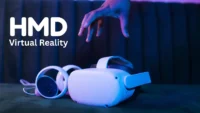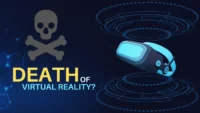Top 7 VR Education Companies (2025)
Published: 21 Mar 2025
Virtual Reality is a technology that lets people experience a computer-generated world as if it were real. VR is becoming a powerful tool in education.
Imagine putting on a VR headset and being inside a spaceship, traveling through the human body, or walking on the surface of Mars. With VR, learning becomes an exciting adventure.
Impact of VR on Learning Experiences
VR makes learning more fun and engaging. Instead of just reading about things in a book, students can experience them, which helps them understand complex ideas more easily.
For example, a history lesson can come to life as students walk through ancient cities. VR also helps students practice skills like flying planes or conducting science experiments safely.
Top VR Education Companies
1. Axon Park
Axon Park is a special place in the virtual world where learning becomes an adventure. It uses VR and artificial intelligence (AI) to create exciting 3D worlds.
One unique feature of Axon Park is its interactive learning environments, where students can explore and learn through activities.
Despite its advanced technology, Axon Park is surprisingly affordable, making it accessible to many educational institutions. It is used in schools and training programs.
Since its founding, Axon Park has made significant progress. It has partnered with other organizations to make online learning safe and effective, and its innovative approach to education has been recognized at essential conferences.
2. Immerse
Immerse is a virtual reality platform designed to help people learn languages engagingly. It creates a virtual world where users can practice speaking with native speakers in real-time.
Immerse focuses on helping users become fluent by immersing them in the language. Instead of studying from books, users can interact with others in the virtual world, helping them practice speaking and listening naturally.
3. Inspirit
Inspirit is a virtual reality platform that interactively helps students learn. It provides many free resources for students, such as 3D models, interactive simulations, and lesson plans.
Students can explore topics like biology, chemistry, and physics hands-on. The platform is easy to access and works on computers and mobile phones.
Inspired has positively impacted STEM education by making learning more engaging and accessible. The platform allows students to explore complex concepts visually and interactively, helping them understand and remember information better. It has also been praised for inspiring students’ curiosity and passion for STEM subjects.
4. Lincoln Electric EMEAR
Lincoln Electric EMEAR is a company that has revolutionized the learning of welding and metal cutting through its innovative use of virtual reality tools.
A fascinating feature of Lincoln Electric’s tools is their ability to simulate realistic welding sounds and even show sparks, making the learning experience truly immersive and exciting.
Lincoln Electric has VR systems like the VRTEX® 360 Compact. These systems let students practice welding by wearing a VR headset. They can see and hear what it’s like to weld metal, helping them learn the proper techniques without risk.
5. The Viktor Rydberg Schools Foundation
The Viktor Rydberg Schools Foundation is a group of schools in Sweden that uses virtual reality (VR) to help students learn in fun and exciting ways.
The foundation uses VR to create virtual classrooms where students learn about history, science, and other subjects. For example, students can visit ancient Rome or explore the human body from the inside.
The foundation provides teachers with tools to create VR lessons. Teachers can design virtual field trips, science experiments, and interactive activities. Students love these tools because they make learning feel like an adventure.
6. Veative Labs
Veative Labs is a company that creates immersive learning experiences for schools using virtual reality (VR).
Their VR tools help students learn by letting them explore virtual worlds. One unique feature is that their VR content is designed to be easy to use and accessible to everyone.
Veative Labs offers various VR modules for science, math, and history subjects. It ensures that its VR content is educational and safe. It provides comprehensive support and training for teachers to integrate VR effectively into their curriculum, track student progress, and offer interactive lessons that help students understand complex concepts.
7. Transfr
Transfr is a company that uses virtual reality to help people learn new job skills. Their VR training programs let users practice real-world tasks in a safe and fun way.
One unique feature is that Transfr offers different training modules for various industries, making it easy for anyone to find a program that fits their needs. Transfr works with many partners to offer its VR training programs.
- Schools use Transfr to help students explore different career paths and gain valuable skills.
- Businesses use the programs to train their employees and improve job performance.
- Governments use Transfr to upskill workers and fill high-demand roles in their communities.
Conclusion
Top VR education companies revolutionizing how students learn by integrating virtual reality into classrooms and training programs. These companies offer unique features and immersive experiences that make learning more engaging and effective.
These companies are transforming education by providing innovative tools for teachers and students and focusing on educational value and safety.
Through their efforts, students can explore new worlds, understand complex topics, and gain valuable skills in a fun and interactive way. The future of education is bright, thanks to the pioneering work of these VR education companies.
FAQ’s
VR offers virtual environments for tasks like welding or flying, eliminating physical risks while letting learners practice safely.
Yes, VR engages visual, auditory, and kinesthetic learners by combining immersive visuals, sounds, and interactive activities.
Teachers can attend VR training sessions, explore interactive modules, and plan lessons using VR tools for maximum impact.
Budget constraints, limited access to technology, and the need for teacher training are common challenges.
No, many VR tools are user-friendly, and designed for easy use by both teachers and students, even without prior tech expertise.
VR brings abstract ideas to life students can explore the human body or watch atoms bond in 3D environments.
Industries like healthcare, aviation, construction, and manufacturing use VR to train workers in real-world tasks.
VR offers resources for all students, including those with disabilities, by creating adaptable and accessible learning experiences.
Advancements like AI-driven VR environments and holographic classrooms could make learning even more personalized.
By turning lessons into adventures, VR captivates students with exciting, hands-on experiences they’ll remember for years.

- Be Respectful
- Stay Relevant
- Stay Positive
- True Feedback
- Encourage Discussion
- Avoid Spamming
- No Fake News
- Don't Copy-Paste
- No Personal Attacks

- Be Respectful
- Stay Relevant
- Stay Positive
- True Feedback
- Encourage Discussion
- Avoid Spamming
- No Fake News
- Don't Copy-Paste
- No Personal Attacks



